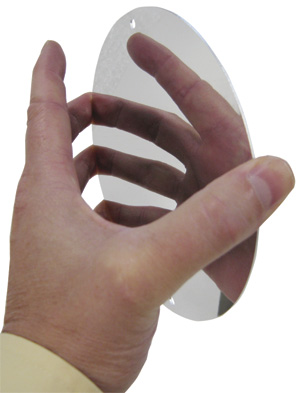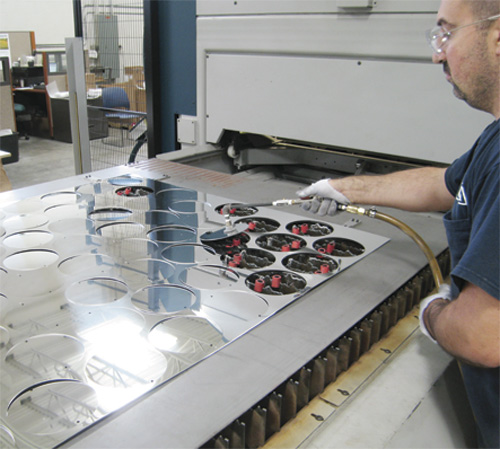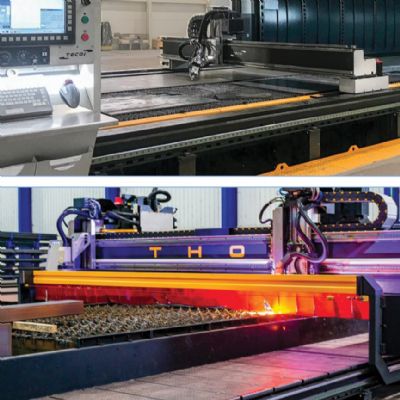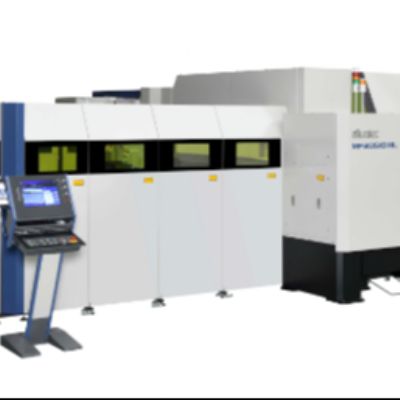Faster, and More Efficient
Ultra Tool’s new fabrication department, which in addition to the laser-cutting machine includes a new press brake, CNC tapping center and a resistance-welding machine, represents part of the firm’s investment over the last five years of more than $6.1 million in new technology. Additional investments have been made in new presses, design software and an inhouse sensor laboratory.
“The first big job our fabrication department earned for us was manufacturing a hydraulic pump bracket for the Nissan Murano,” shares Hansen. Laser blanking and then forming the bracket (on a new Durma 150-ton CNC press brake) saved the shop’s customer more than $120,000 in up-front tooling costs that would have taken more than 8 yr. to achieve a complete return on investment. Volumes for the pump bracket part are 15,000/yr.; Ultra Tool produces the parts in lot sizes of 1000 to 1500.
Ultra Tool typically employs its new laser-cutting machine to cut mild-steel plate to 3⁄8 in. thick, and at times runs ½-in. plate through the machine; it’s rated for steel to 0.70 in. thick. The shop also cuts stainless steel to 1⁄8 in. (Salvagnini rates the machine for 0.312-in. stainless) as well as aluminum to 1⁄8 in.—the machine is rated to 0.187-in. aluminum, brass and copper.
Where’s the fiber-laser advantage on steel compared to a CO2 laser? Hansen came to understand the advantage back in 2009 when he attended a seminar at local equipment distributor Weller Machinery, in Germantown, WI. Weller’s representatives (as do other laser-cutting-machine vendors) generally note that when cutting 20-gauge steel sheet, for example, a 2-kW fiber laser will cut twice as quickly as will a 4-kW CO2 laser. And, the process will be nearly three times as energy efficient (around 30 percent for a fiber laser compared to 10 to 15 percent for a CO2 laser). Hansen left the Weller Machinery seminar convinced that fiber-laser technology was the perfect fit for his new fabrication department, and remains confident that the machine will continue to attract new customers in new markets to his company.
New Horizons
“The fabrication department is critical to our growth potential,” says Hansen. “We’re finding that the new customers we’re attracting not only appreciate the efficiency with which we can fabricate, but also are attracted by the refined and mature quality and delivery systems we have in place.”
Hansen also notes that even though his firm has been running the fiber-laser cutting machine for just over a year, it’s already at 30-percent capacity and gaining ground. The master plan calls for adding automation to the laser—a material storage tower and sheet loader, to store and move blanks in and out of the laser—when the workload requires it.
“We laid out the department specifically with material-handling automation in mind,” says Hansen. “We’re in the process of beefing up our sales force and investing in marketing to promote our new fabricating services. As we grow, we’ll add press brakes to boost capacity of the fabrication shop. The sky is the limit.” MFView Glossary of Metalforming Terms
See also: Salvagnini America, Inc.
Technologies: Cutting, Pressroom Automation











